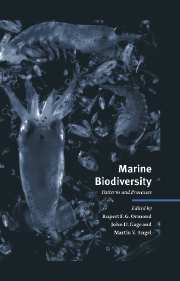Book contents
- Frontmatter
- Contents
- List of contributors
- Foreword: The value of diversity
- 1 Marine biodiversity in its global context
- 2 Gradients in marine biodiversity
- 3 Pelagic biodiversity
- 4 Biological diversity in oceanic macrozooplankton: More than counting species
- 5 Large-scale patterns of species diversity in the deep-sea benthos
- 6 Diversity, latitude and time: Patterns in the shallow sea
- 7 High benthic species diversity in deep-sea sediments: The importance of hydrodynamics
- 8 Diversity and structure of tropical Indo-Pacific benthic communities: Relation to regimes of nutrient input
- 9 Why are coral reef communities so diverse?
- 10 The biodiversity of coral reef fishes
- 11 The historical component of marine taxonomic diversity gradients
- 12 Population genetics and demography of marine species
- 13 Discovering unrecognised diversity among marine molluscs
- 14 Ecosystem function at low biodiversity – the Baltic example
- 15 Land–seascape diversity of the USA East Coast coastal zone with particular reference to estuaries
- 16 The development of mariculture and its implications for biodiversity
- 17 Protecting marine biodiversity and integrated coastal zone management
- 18 Conserving biodiversity in North-East Atlantic marine ecosystems
- Author index
- Species index
- Subject index
16 - The development of mariculture and its implications for biodiversity
Published online by Cambridge University Press: 04 August 2010
- Frontmatter
- Contents
- List of contributors
- Foreword: The value of diversity
- 1 Marine biodiversity in its global context
- 2 Gradients in marine biodiversity
- 3 Pelagic biodiversity
- 4 Biological diversity in oceanic macrozooplankton: More than counting species
- 5 Large-scale patterns of species diversity in the deep-sea benthos
- 6 Diversity, latitude and time: Patterns in the shallow sea
- 7 High benthic species diversity in deep-sea sediments: The importance of hydrodynamics
- 8 Diversity and structure of tropical Indo-Pacific benthic communities: Relation to regimes of nutrient input
- 9 Why are coral reef communities so diverse?
- 10 The biodiversity of coral reef fishes
- 11 The historical component of marine taxonomic diversity gradients
- 12 Population genetics and demography of marine species
- 13 Discovering unrecognised diversity among marine molluscs
- 14 Ecosystem function at low biodiversity – the Baltic example
- 15 Land–seascape diversity of the USA East Coast coastal zone with particular reference to estuaries
- 16 The development of mariculture and its implications for biodiversity
- 17 Protecting marine biodiversity and integrated coastal zone management
- 18 Conserving biodiversity in North-East Atlantic marine ecosystems
- Author index
- Species index
- Subject index
Summary
Abstract
Mariculture has become an important source of seaweed, shellfish and fish, especially for human food, and production is likely to continue to expand well into the next century.
Mariculture has both direct and indirect impacts on biodiversity through the consumption of natural resources and the production of wastes. Natural resources such as land, water, seed and feed are required, consumption varying with intensity of production. Wastes, comprising uneaten food, faecal and urinary products, chemicals, pathogens and feral animals, are released into the environment, quantities also being largely dependent upon production methods.
Particular attention is drawn to threats to marine biodiversity posed by wetland destruction, use of chemotherapeutants and translocation of exotic plants and animals. Awareness of the impact of mariculture on biodiversity, however, is growing. Legislative, economic and market forces are beginning to persuade producers to reduce the impact through the adoption of a range of measures, including better site selection, husbandry, waste collection and treatment methods. Mariculture technology also offers the possibilities of reducing the impact on marine biodiversity caused by fishing and by entrapment of anthropogenic wastes from coastal conurbations.
Introduction
World population continues to increase faster than global food supply. While 99% of food comes from terrestrial agriculture (Pimentel & Giampietro, 1994), this disguises the fact that in many, especially developing, countries the bulk of animal protein comes from fish and other aquatic products.
- Type
- Chapter
- Information
- Marine BiodiversityPatterns and Processes, pp. 372 - 393Publisher: Cambridge University PressPrint publication year: 1997
- 7
- Cited by



